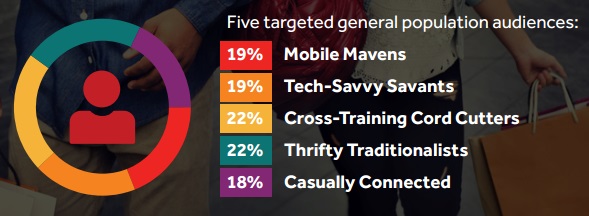Marketers often bundle all ‘millennials’ into the same category, but new research suggests this age group is more diverse and complex than is conventionally assumed.
Global audience technology company surveyed more than 5,000 consumers to understand how cultural, environmental and life events influence purchase behaviour, media viewing habits, device preferences and the impact on consumer marketing.
The team created five unique targeted audiences: Mobile Mavens (19%), Tech-Savvy Savants (19%), Cross-Training Cord Cutters (22%), Thrifty Traditionalists (22%) and the Casually Connected (18%).
The study found that while there are common characteristics that define the entire generation, there is more depth and nuance to the audience that advertisers should be aware of in order to influence this segment and drive higher engagement.
Millennials are more likely to watch TV shows than older generations but are less likely to watch cable television, according to the study.
They are turning to streaming and downloading for video and are much more likely to watch video content of any sort: movies, music, and web videos. Because of these technology attachments, it may be assumed that Millennials have completely delineated their habits from other generations.
However, the research demonstrates that they are only incrementally different from other generations.
Key findings of the study include:
• Millennials are more diverse and complex than is conventionally assumed. Millennials differ from other generations in more ways than just age. Millennials were broken into five separate segments, each with different needs, informing what media they consume, what they purchase and their ad preferences.
• Generational or age-based segmentation does not define factors that drive behaviour. Targeting audiences based solely on birth year is a very broad and ineffective method for understanding and segmenting audiences. Segments are not necessarily age specific; they transcend generational boundaries and audience segmentation, providing a holistic approach to actionable insights driven by factors that truly influence their behaviours and purchase decisions.
• Segmentation insight gives advertisers a clear picture of which marketing efforts will make the biggest impact. Messaging and creative should be crafted to connect with individual consumer segments, not necessarily the generation they were born into.

“Our goal was to evaluate the Millennial audience to create a more comprehensive picture of the audience segment that makes up this highly sought-after generation,” said Paul Neto, Senior Research Director at YuMe. “Using the profiles we’ve established for each segment, advertisers can plan future projects with clarity and precision, ensuring the tone and content of their ads, media and device path, as well as brand and product are aligned with the audience.”
Millennials Evolved takes audience segmentation beyond age or generation gaps and defines consumers based on fundamental factors, such as their different value systems, and their approach to media, advertising and shopping.
Using this segmentation analysis, YuMe created the following audience segments: Mobile Mavens, Tech-Savvy Savants, Cross-Training Cord Cutters, Thrifty Traditionalists, and Causally Connected.
Each of these audience segments are profiled within in the eBook, including details like demographics, likely career path, shopping, health, fitness and technology habits, and advertising preferences.
“Marketers must go beyond the stereotypical definition of the Millennial consumer, taking into account all of the nuances that make this generation unique, in order to deliver impactful campaigns,” said Stephanie Gaines, Vice President, Corporate Marketing at YuMe. “This study reinforces the vital importance of highly focused audience building and segmentation, leveraging key behavioural and psychographic insights that drive engagement and can be the difference between a highly successful or lacklustre campaign.”
YuMe used Interpret to survey more than 5,000 US-based consumers over the age of 18 with 120+ questions concerning media consumption, device usage and advertising preferences to measure critical customer patterns that lead directly to consumption, advocacy and sales.

